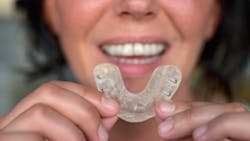Simple and desperately needed, hard mouth guards may be the most neglected procedure among the vast panoply of modern dental wonders. As I’ll demonstrate, I suspect to your amazement, that when ideal systems are employed, this appliance’s profit potential is more than triple that of the often-exalted crown. Also, fabrication requires less of the intensity demanded by crowns and bridges and involves none of the significant risks, such as requiring postinsertion endo or developing marginal decay. In skilled hands, mouth guards can be a life-changing blessing for patients enduring temporomandibular joint (TMJ) pain.
Indications for mouth guards include:
TMJ syndrome. While not all are treated, I diagnose about 10 TMJ cases a week. My secret screening technique is to watch as patients open their mouths. If, instead of moving in a nondeviated vertical path, the mandible moves side-to-side or cants hard left or right, I inquire, “How much trouble are you having with headaches?”
Patients invariably respond, “A lot! How did you know?”
There’s much more to TMJ than this elementary observation; enough to fill a textbook or 50. But detailing definitive diagnosis and treatment is beyond this article’s scope. I also have no interest in entering the dialogue regarding “is TMJ bite-related?” After 40 years of seeing pain disappear—sometimes almost instantly—after inserting a properly adjusted mouth guard, the debate is moot. I know that conservative, completely reversible treatment of this debilitating malady dramatically enhances the quality of many patients’ lives, and I’m honored to provide such valuable assistance. (Soft mouth guards like the old boil-and-bite design should be limited to sports protection. It has been my observation that sleeping in a soft guard usually exacerbates TMJ pain.)
More from this author:
Getting off on the right foot: The new patient call slip
Trouble with your schedule? Set it up for success.
Don’t inject the palate again! Use this simple and straightforward method
Cervical abrasion and abfraction lesions. To tell if these common, sometimes painful areas are bite-related, check the occlusion. I believe you’ll find the hardest contact to be on teeth with the deepest cervical lesions. There are numerous palliative ways to treat cervical sensitivity—the large number of solutions indicating that none are very effective. But correcting occlusal prematurities, relieving symptoms, thus allowing suffering patients to enjoy sweet and cold things again, creates enthusiastic practice missionaries.
Extreme wear and fractured teeth. Many of my midwestern patients are involved in agricultural and construction-related fields. They ingest more than a healthy mouthful of microscopic “grit” daily, which can cause occlusal destruction so severe that multiple root canals are needed. The wear worsens in the less-bulky anterior region, where tooth structure loss destroys esthetics by creating an inverted smile line. Before attempting corrective treatment, the cause of oral breakdown must be eliminated (bruxism), or extensive treatment will fail.
Protection of restorations. As a continuation of my last point, any patient with parafunctional oral habits treated with veneers, bonding, crowns, etc., should sleep in a hard guard. It’s much easier to fabricate a mouth guard than to perfectly match veneers after a central incisor has fractured.
I’ve heard Dr. Gordon Christensen, who seems to know a lot about such matters (and everything else), inform his massive and enthusiastic audiences about the crucial need for mouth guards. No opinion is more respected than Dr. Christensen’s, so it is puzzling why so few dentists have acted on his sagacious advice. I believe there are two primary reasons why this preeminent leader hasn’t gotten the anticipated response to his plea.
The first reason is that many dentists don’t understand occlusion. I sadly believe this, having treated a lot of iatrogenic disease. Many patients suffer for years because a crown, restoration, or denture painfully retrudes their mandible upon closure. But within every crisis lies opportunity. The dentist who corrects the occlusion and stops the almost-daily pain is a hero. I can often accomplish this task in mere minutes.
It’s not easy, but it’s also not a choice. Dentists must understand occlusion. The Pankey Institute, Dr. Christensen, and others offer excellent courses on this foundational topic that many don’t fully comprehend upon leaving dental school. Once one masters occlusion, consistently delivering exceptional dentistry of every ilk becomes easier and more predictable.
The second reason? Dentists don’t know how to present this care or think it’s unprofitable to fabricate mouth guards. I’m going to detail my system, which I believe will convince the most obdurate that this exemplary service can be performed quickly, simply, and profitably by anyone who understands occlusion.
I complete diagnosis and treatment planning for a mouth guard during a recare or new-patient examination. I demonstrate specific mouth guard indications on our intraoral camera, showing patients wear facets, abfraction lesions, severe anterior abrasion causing cosmetic concerns, mobile or broken teeth, or fractured restorations. Once I’ve established the need for treatment and explained the possible consequences of nontreatment, I display a sample mouth guard and answer questions. In our area, many dental and medical insurance carriers cover mouth guards.
The excellent study models and bites (centric and protrusive) needed to create a mouth guard are usually taken by my hygiene assistant that same day. We charge a study model fee, but I will not include it in the profit analysis since it is a separate procedure.
Besides discussing a mouth guard during an existing appointment, my total time requirement is 10 minutes to refine the occlusion upon insertion. We schedule patients for 20 minutes with our in-house lab technician, who fabricates the appliance. He does preliminary fit and occlusal adjustments and is so skilled that I usually have about five minutes of my 10-minute appointment remaining. An experienced chairside assistant can also perform this adjustment.
Because I have an in-house lab, my cost is approximately $20, but the average lab cost for this appliance is $135. The fee we charge (ADA code 9944—hard appliance full arch) is $500, which yields a net profit of $365 ($500 - $135). Since total doctor time is one-sixth of an hour (10 minutes), our hourly net profit is $2,190 (6 x $365). I know specialists who charge $1,000+ for this appliance, so these figures are highly conservative.
This calculation doesn’t include any additional overhead, and the lab bill and net profit will vary depending on the laboratory chosen and one’s skill at mouth-guard fabrication. However, these figures ought to provide food for thought for those not bothering to treat occlusal problems. As a basis for comparison, let’s calculate a similar rough net profit for a single crown.
Let’s assume a crown fee of $1,000 and a lab bill of $175 for semiprecious metal. Crown net after lab is $825 ($1,000 - $175). If 80 minutes of doctor time is required to prep and seat the restoration, the net per hour is $620 ($820/1.33 hours). The per-hour mouth guard net of $2,170 is 340% of the per-hour crown net of $620. Please substitute your fee, lab bill, and scheduled time to personalize this comparison.
Do your practice, your patients, and yourself a favor by becoming a student of occlusion, like all master dentists. One who attains this knowledge should fabricate a minimum of two mouth guards a week. (The least behaviorally adept can gain case acceptance for a simple, noninvasive technique that protects dentition and ends daily headaches for $500!)
Helping patients with the above-delineated problems is our professional obligation. If dentists won’t treat occlusal issues, who will? Also, consider that $365 x 2 per week x 50 weeks = $36,500 of additional profit per year. This service dramatically reduces patient suffering, thus enhancing the reputation of your practice and our at-times maligned profession. What more could you ask for?
Editor's note: This article appeared in the November 2021 print edition of Dental Economics.
About the Author

John A. Wilde, DDS
After eight years of higher education, paying 100% of the cost himself, John A. Wilde, DDS, spent two years in the Army Dental Corps before beginning a practice from scratch in Keokuk, Iowa. By age 30, he was debt-free, owning outright his new country home and the practice he had designed and built. By 40, he was financially able to retire. At age 53, he fully retired. Dr. Wilde has authored six books and more than 220 articles, and may be reached at (309) 333-2865 or [email protected].
